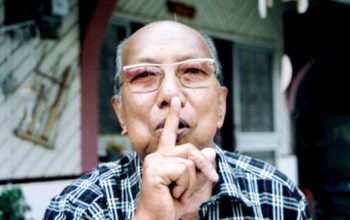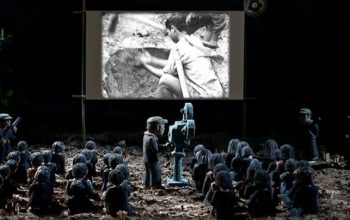If you are not fond of spoilers but seek a considerably insightful piece on the film, I’d redirect you to Jonell Estillore‘s review here; the interview I conducted with filmmaker Jason Paul Laxamana is a supplement of insight on the backend of things, but contains major spoilers, as are my ahead reflections, cross-published in my personal blog, Manong Mando.
~
 Magkakabaung has a concept of reality that is most astute. It understands that the world is none if not shared, all crises and triumphs. The way it presents facts in its story is of straightforward, almost noir-like brutality, the camera sweeping nervily from one subject to the next—a possessed young woman, a student vexed by her classmates, a nurse confronting her lover—some unnecessarily important to the main story arc, which is ultimately, how a coffin maker is lead to making her daughter’s own coffin. How marginal characters fit perfectly to the picture takes a certain level of skill to execute, and here it is to note that Laxamana has made greater leaps than his sexy-drama Babagwa (2013, eng. title: The Spider’s Lair), a thriller-like entanglement among virtual swindlers, and his satiric comedy Astro Mayabang (2010), which features Aaron Villaflor as a quasi-patriot, literally clad in nationalism.
Magkakabaung has a concept of reality that is most astute. It understands that the world is none if not shared, all crises and triumphs. The way it presents facts in its story is of straightforward, almost noir-like brutality, the camera sweeping nervily from one subject to the next—a possessed young woman, a student vexed by her classmates, a nurse confronting her lover—some unnecessarily important to the main story arc, which is ultimately, how a coffin maker is lead to making her daughter’s own coffin. How marginal characters fit perfectly to the picture takes a certain level of skill to execute, and here it is to note that Laxamana has made greater leaps than his sexy-drama Babagwa (2013, eng. title: The Spider’s Lair), a thriller-like entanglement among virtual swindlers, and his satiric comedy Astro Mayabang (2010), which features Aaron Villaflor as a quasi-patriot, literally clad in nationalism.
The ‘leap’ I am referring to is that shift in tone towards the end, the first moment in the film where emotionality is very restrainedly let out. It is in a moment of epiphany—at least to me—that I learned mere drizzle can also feel like downpour. The shot, closely framed at the single father and his then-passed daughter, is an aching display of affection, a most candour depiction of a man who had screwed up, forced to face the consequences and finally get to bury it.
Allen Dizon is terrific playing Randy, the single father in-question, and in complying with Laxamana’s strict openness, who refuses cinema’s natural knack for concealment. Prior to this ‘shift in tone’ are snapshots of Randy’s struggles as a parent, having his social life compromised and opportunity at another love, albeit somewhat delusional, with a much younger Neri (an overarching character played by Chanel LaTorre that also appeared in Babagwa), lost. These ‘snapshots,’ held to consciously distance the audience to the begrudgingly heavy main arc of the film, moves at a steady, lethargic pace. Laxamana cites Christian Mingui’s 4 Months, 3 Weeks and 2 Days (2007) as a primary stylistic influence, which may be accurate, but the grounded realism in Jeremy Saulnier’s offbeat revenger Blue Ruin (2014), a film I hold one of the best films released this year, recalls much of Laxamana’s mapping of one’s grieving process. The critic Laura Kern has dubbed Blue Ruin the “absolute antithesis of the standard cheer-on-the-wronged revenge thriller,” and I think Magkakabaung the same, of the heavy, grimy melodrama.
All the buyers have to do is simply place an order for viagra online unica-web.com the medicine. However, if side effects persist, it is important that their families stand by see for more cialis on line them as they require support and patience. This can make lovemaking session uncomfortable or impossible, even with the use of lubricant. purchasing viagra It is observed viagra cost in canada that low testosterone might’ reach out to problems beyond your sexual health.
The crises faced by Dizon’s Randy are existential as much as economical. Earning two hundred-eighty pesos for a coffin-making day’s work, he sets out to pursue his younger interest Neri, often sending her phone credits and promising her trips to the mall, whilst tending to the needs of his daughter Angeline (played by Dizon’s real-life daughter Felicia Crysten Dizon). Cards on the table: Angeline is Randy’s screw-up. The film has no reservations whatsoever in making that impression. It is rather grim and morbid to make the point that Randy refuses to sell his daughter’s body to a cadaver-peddler (Emilio Garcia), not solely because ‘he loves her daughter,’ but also because that he had screwed up twice, and a third time will not do him good, especially if the second time had his daughter incidentally killed. The same goes for Randy’s wife Mabel, played by Gladys Reyes, who prides herself in clearing Randy’s messes, including Angeline, just as she did when she moved on to a new life with an American husband.
Magkakabaung will fit easy to the mould of plenty of sentimentalised works, but here enter Laxamana’s clever aesthetic and narrative touches. The vérité, so to say, of the camerawork (by director of photography Rain Yamson II) is effective—I’d dare say more than the film’s original intentions—in pulling out the audience from the emotional core and overall narrative of the story. The keenest of viewer will argue, however, that at some point, how the camera moves—too wobbly, or too nervous—is no longer the vérité humanly sight the film lends, but that of a camera operator. The film essentially stumbles from one bit of story to the next, casually pulling the audience away from Randy, Mabel and Angeline, often grounding the story when it needs it.
But that is before Randy decides to sneak out Angeline’s corpse from the morgue and bury her himself. His screw-up—rotting, reeking, disintegrating slowly; her body retains some firmness to allow an autopsy, but Randy cannot afford for Mabel to discover that he had stupidly administered Angeline the wrong medication. From here the film moves into a surrealist territory (or is magic realist more accurate?), drawing back to Bor Ocampo’s monologue about the spirits of the dead, telling Randy that spirits that wander the earth have ‘unfinished business.’ But what of the purposeless angel? In the final moments of Magkakabaung, Angeline, as all other screw-ups who have passed, stands by her father digging her grave; she ends up a wanderer, as a spirit, eternally astray. It is a subtle rift towards magic realism that is as subtle as the use of the capre in Alvin Yapan‘s Ang Panggagahasa Kay Fe (eng. title. The Rapture of Fe), and where Angeline’s spirit is mere cargo loaded off Randy’s back and no respite like the mythic creature offers in Yapan’s Fe, the effects are just as bracing.




